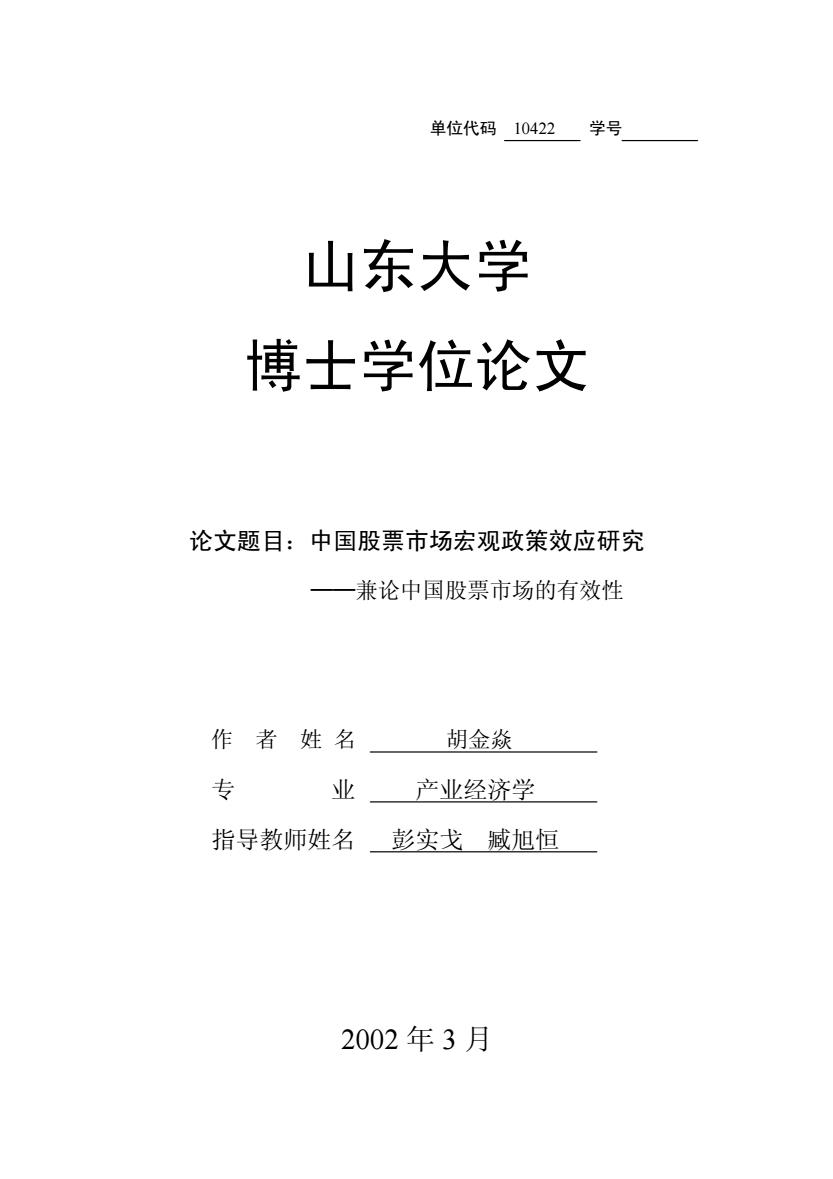
单位代码10422 学号 山东大学 博士学位论文 论文题目:中国股票市场宏观政策效应研究 —兼论中国股票市场的有效性 作者姓名 胡金焱 专 业 产业经济学 指导教师姓名 彭实戈臧旭恒 2002年3月
单位代码 10422 学号 山东大学 博士学位论文 论文题目:中国股票市场宏观政策效应研究 ——兼论中国股票市场的有效性 作 者 姓 名 胡金焱 专 业 产业经济学 指导教师姓名 彭实戈 臧旭恒 2002 年 3 月
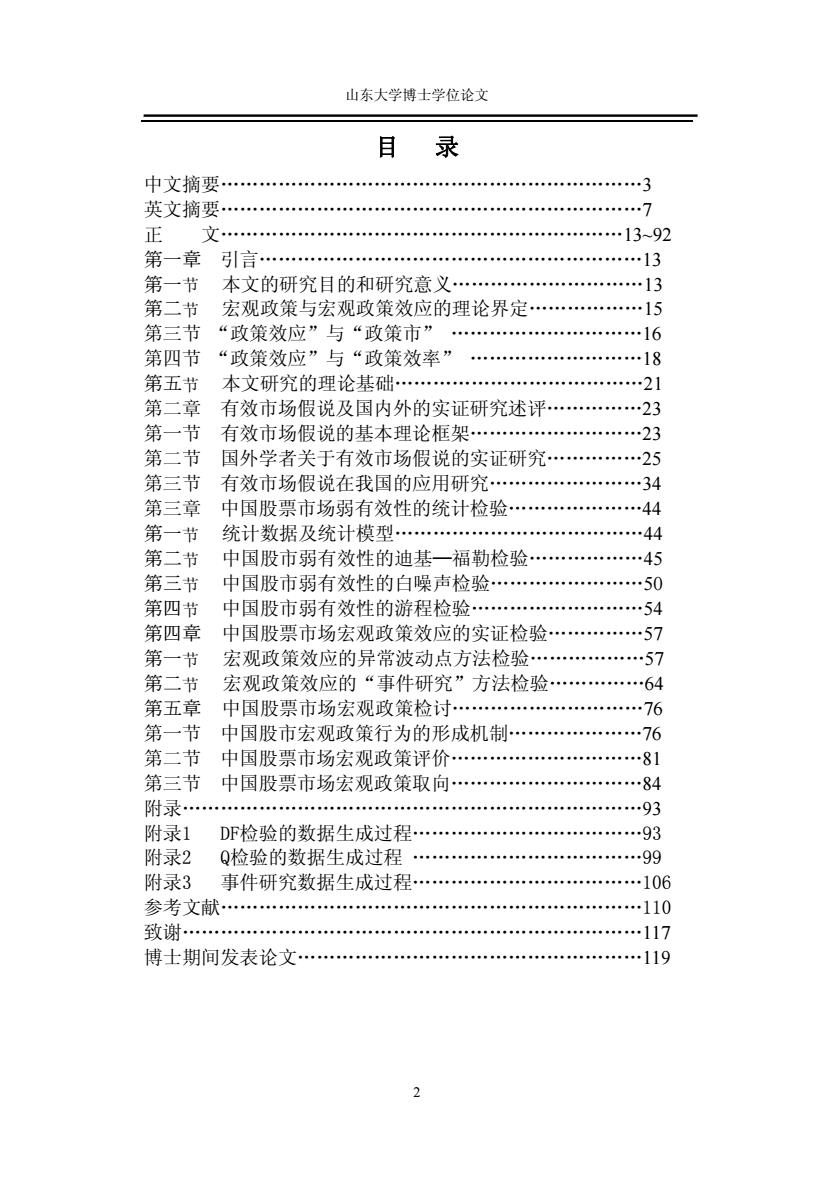
山东大学博士学位论文 目 录 中文摘要… 0……3 英文摘要… …7 正 文… …1392 第一章 引言… …13 第一节 本文的研究目的和研究意义… …13 第二节 宏观政策与宏观政策效应的理论界定…15 第三节 “政策效应”与“政策市” …16 第四节 “政策效应”与“政策效率”… …18 第五节 本文研究的理论基础………21 第二章 有效市场假说及国内外的实证研究述评…23 第一节 有效市场假说的基本理论框架…23 第二节 国外学者关于有效市场假说的实证研究…25 第三节 有效市场假说在我国的应用研究…34 第三章中国股票市场弱有效性的统计检验…44 第一节 统计数据及统计模型…44 第二节 中国股市弱有效性的迪基一福勒检验…45 第三节 中国股市弱有效性的白噪声检验… …50 第四节 中国股市弱有效性的游程检验… …54 第四章 中国股票市场宏观政策效应的实证检验 …57 第一节 宏观政策效应的异常波动点方法检验…57 第二节 宏观政策效应的“事件研究”方法检验…64 第五章 中国股票市场宏观政策检讨…76 第一节 中国股市宏观政策行为的形成机制…76 第二节 中国股票市场宏观政策评价…81 第三节中国股票市场宏观政策取向…84 附录…93 附录1 DF检验的数据生成过程…… …93 附录2 Q检验的数据生成过程 …99 附录3 事件研究数据生成过程… *…106 参考文献… …110 致谢… …117 博士期间发表论文· …119
山东大学博士学位论文 2 目 录 中文摘要…………………………………………………………3 英文摘要…………………………………………………………7 正 文………………………………………………………13~92 第一章 引言……………………………………………………13 第一节 本文的研究目的和研究意义…………………………13 第二节 宏观政策与宏观政策效应的理论界定………………15 第三节 “政策效应”与“政策市” …………………………16 第四节 “政策效应”与“政策效率” ………………………18 第五节 本文研究的理论基础…………………………………21 第二章 有效市场假说及国内外的实证研究述评……………23 第一节 有效市场假说的基本理论框架………………………23 第二节 国外学者关于有效市场假说的实证研究……………25 第三节 有效市场假说在我国的应用研究……………………34 第三章 中国股票市场弱有效性的统计检验…………………44 第一节 统计数据及统计模型…………………………………44 第二节 中国股市弱有效性的迪基—福勒检验………………45 第三节 中国股市弱有效性的白噪声检验……………………50 第四节 中国股市弱有效性的游程检验………………………54 第四章 中国股票市场宏观政策效应的实证检验……………57 第一节 宏观政策效应的异常波动点方法检验………………57 第二节 宏观政策效应的“事件研究”方法检验……………64 第五章 中国股票市场宏观政策检讨…………………………76 第一节 中国股市宏观政策行为的形成机制…………………76 第二节 中国股票市场宏观政策评价…………………………81 第三节 中国股票市场宏观政策取向…………………………84 附录………………………………………………………………93 附录1 DF检验的数据生成过程………………………………93 附录2 Q检验的数据生成过程 ………………………………99 附录3 事件研究数据生成过程………………………………106 参考文献…………………………………………………………110 致谢………………………………………………………………117 博士期间发表论文………………………………………………119
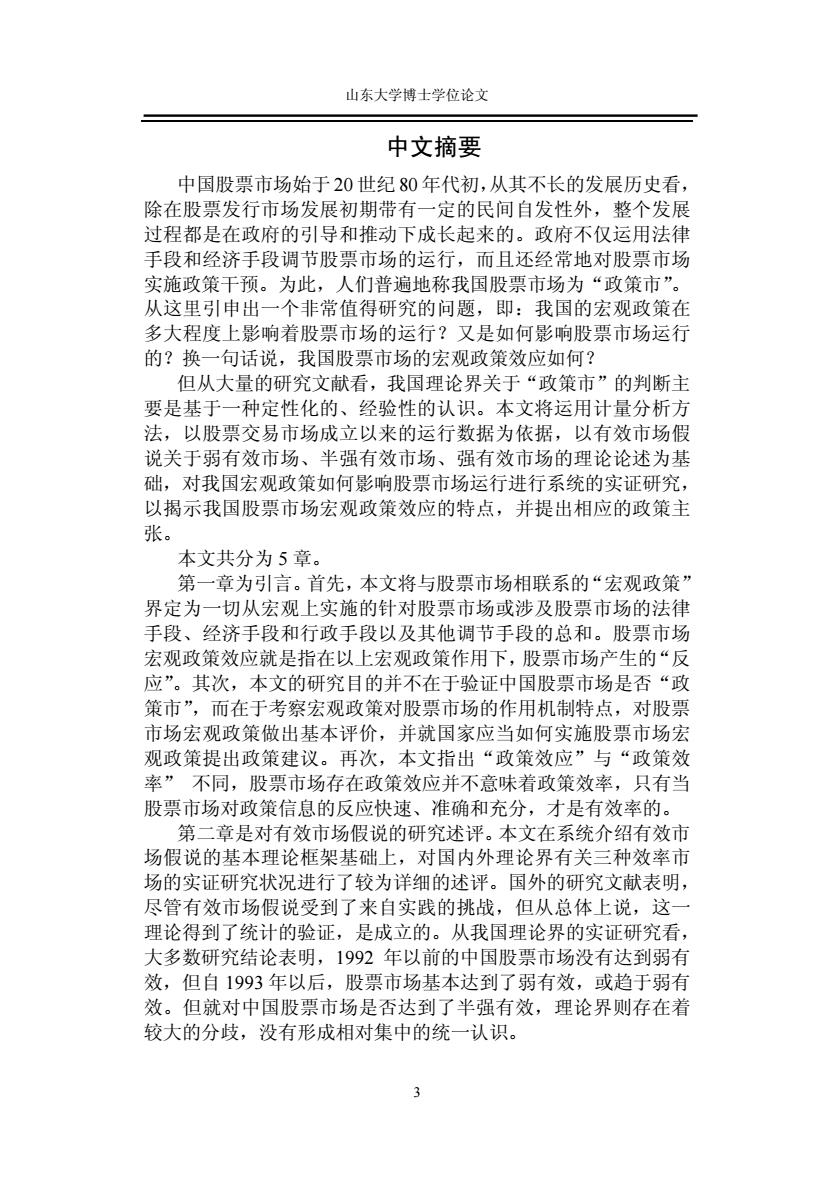
山东大学博士学位论文 中文摘要 中国股票市场始于20世纪80年代初,从其不长的发展历史看, 除在股票发行市场发展初期带有一定的民间自发性外,整个发展 过程都是在政府的引导和推动下成长起来的。政府不仅运用法律 手段和经济手段调节股票市场的运行,而且还经常地对股票市场 实施政策干预。为此,人们普遍地称我国股票市场为“政策市”。 从这里引申出一个非常值得研究的问题,即:我国的宏观政策在 多大程度上影响着股票市场的运行?又是如何影响股票市场运行 的?换一句话说,我国股票市场的宏观政策效应如何? 但从大量的研究文献看,我国理论界关于“政策市”的判断主 要是基于一种定性化的、经验性的认识。本文将运用计量分析方 法,以股票交易市场成立以来的运行数据为依据,以有效市场假 说关于弱有效市场、半强有效市场、强有效市场的理论论述为基 础,对我国宏观政策如何影响股票市场运行进行系统的实证研究, 以揭示我国股票市场宏观政策效应的特点,并提出相应的政策主 张。 本文共分为5章。 第一章为引言。首先,本文将与股票市场相联系的“宏观政策” 界定为一切从宏观上实施的针对股票市场或涉及股票市场的法律 手段、经济手段和行政手段以及其他调节手段的总和。股票市场 宏观政策效应就是指在以上宏观政策作用下,股票市场产生的“反 应”。其次,本文的研究目的并不在于验证中国股票市场是否“政 策市”,而在于考察宏观政策对股票市场的作用机制特点,对股票 市场宏观政策做出基本评价,并就国家应当如何实施股票市场宏 观政策提出政策建议。再次,本文指出“政策效应”与“政策效 率”不同,股票市场存在政策效应并不意味着政策效率,只有当 股票市场对政策信息的反应快速、准确和充分,才是有效率的。 第二章是对有效市场假说的研究述评。本文在系统介绍有效市 场假说的基本理论框架基础上,对国内外理论界有关三种效率市 场的实证研究状况进行了较为详细的述评。国外的研究文献表明, 尽管有效市场假说受到了来自实践的挑战,但从总体上说,这一 理论得到了统计的验证,是成立的。从我国理论界的实证研究看, 大多数研究结论表明,1992年以前的中国股票市场没有达到弱有 效,但自1993年以后,股票市场基本达到了弱有效,或趋于弱有 效。但就对中国股票市场是否达到了半强有效,理论界则存在着 较大的分歧,没有形成相对集中的统一认识。 3
山东大学博士学位论文 3 中文摘要 中国股票市场始于 20 世纪 80 年代初,从其不长的发展历史看, 除在股票发行市场发展初期带有一定的民间自发性外,整个发展 过程都是在政府的引导和推动下成长起来的。政府不仅运用法律 手段和经济手段调节股票市场的运行,而且还经常地对股票市场 实施政策干预。为此,人们普遍地称我国股票市场为“政策市”。 从这里引申出一个非常值得研究的问题,即:我国的宏观政策在 多大程度上影响着股票市场的运行?又是如何影响股票市场运行 的?换一句话说,我国股票市场的宏观政策效应如何? 但从大量的研究文献看,我国理论界关于“政策市”的判断主 要是基于一种定性化的、经验性的认识。本文将运用计量分析方 法,以股票交易市场成立以来的运行数据为依据,以有效市场假 说关于弱有效市场、半强有效市场、强有效市场的理论论述为基 础,对我国宏观政策如何影响股票市场运行进行系统的实证研究, 以揭示我国股票市场宏观政策效应的特点,并提出相应的政策主 张。 本文共分为 5 章。 第一章为引言。首先,本文将与股票市场相联系的“宏观政策” 界定为一切从宏观上实施的针对股票市场或涉及股票市场的法律 手段、经济手段和行政手段以及其他调节手段的总和。股票市场 宏观政策效应就是指在以上宏观政策作用下,股票市场产生的“反 应”。其次,本文的研究目的并不在于验证中国股票市场是否“政 策市”,而在于考察宏观政策对股票市场的作用机制特点,对股票 市场宏观政策做出基本评价,并就国家应当如何实施股票市场宏 观政策提出政策建议。再次,本文指出“政策效应”与“政策效 率” 不同,股票市场存在政策效应并不意味着政策效率,只有当 股票市场对政策信息的反应快速、准确和充分,才是有效率的。 第二章是对有效市场假说的研究述评。本文在系统介绍有效市 场假说的基本理论框架基础上,对国内外理论界有关三种效率市 场的实证研究状况进行了较为详细的述评。国外的研究文献表明, 尽管有效市场假说受到了来自实践的挑战,但从总体上说,这一 理论得到了统计的验证,是成立的。从我国理论界的实证研究看, 大多数研究结论表明,1992 年以前的中国股票市场没有达到弱有 效,但自 1993 年以后,股票市场基本达到了弱有效,或趋于弱有 效。但就对中国股票市场是否达到了半强有效,理论界则存在着 较大的分歧,没有形成相对集中的统一认识
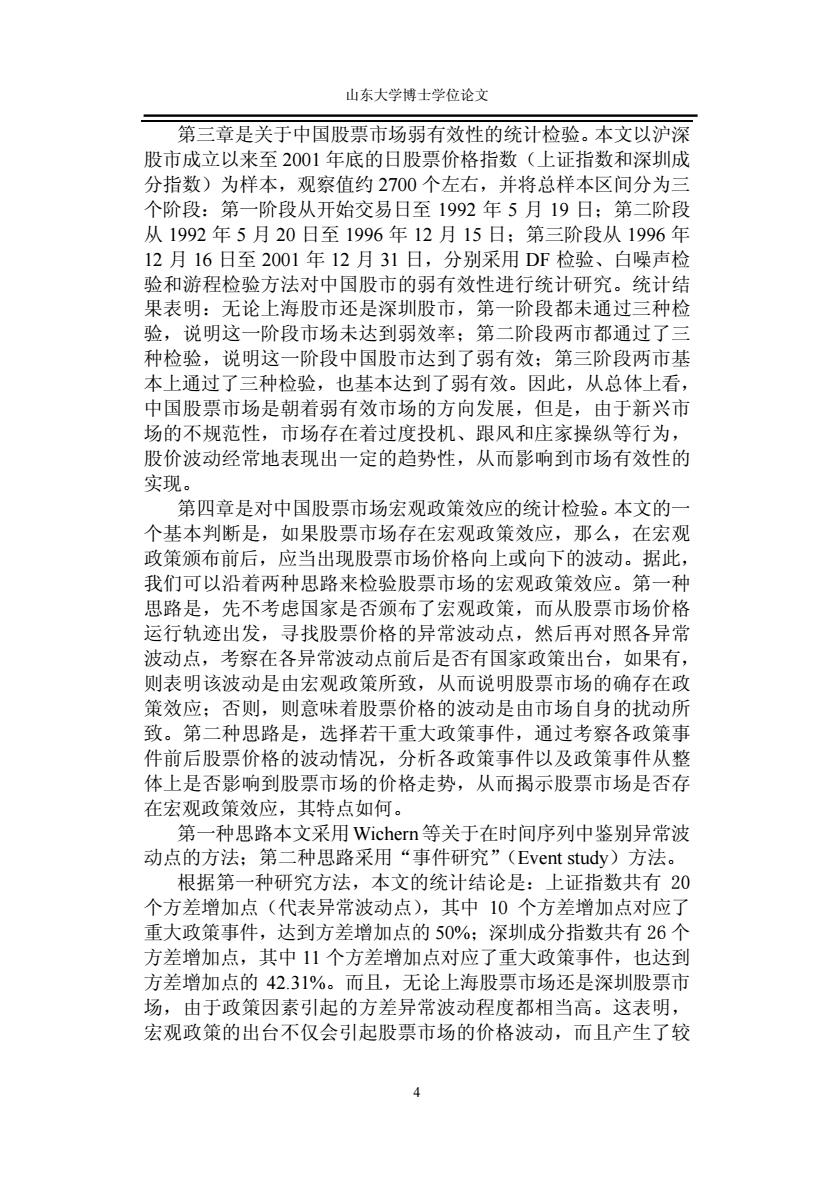
山东大学博士学位论文 第三章是关于中国股票市场弱有效性的统计检验。本文以沪深 股市成立以来至2001年底的日股票价格指数(上证指数和深圳成 分指数)为样本,观察值约2700个左右,并将总样本区间分为三 个阶段:第一阶段从开始交易日至1992年5月19日:第二阶段 从1992年5月20日至1996年12月15日:第三阶段从1996年 12月16日至2001年12月31日,分别采用DF检验、白噪声检 验和游程检验方法对中国股市的弱有效性进行统计研究。统计结 果表明:无论上海股市还是深圳股市,第一阶段都未通过三种检 验,说明这一阶段市场未达到弱效率;第二阶段两市都通过了三 种检验,说明这一阶段中国股市达到了弱有效:第三阶段两市基 本上通过了三种检验,也基本达到了弱有效。因此,从总体上看, 中国股票市场是朝着弱有效市场的方向发展,但是,由于新兴市 场的不规范性,市场存在着过度投机、跟风和庄家操纵等行为, 股价波动经常地表现出一定的趋势性,从而影响到市场有效性的 实现。 第四章是对中国股票市场宏观政策效应的统计检验。本文的一 个基本判断是,如果股票市场存在宏观政策效应,那么,在宏观 政策颁布前后,应当出现股票市场价格向上或向下的波动。据此, 我们可以沿着两种思路来检验股票市场的宏观政策效应。第一种 思路是,先不考虑国家是否颁布了宏观政策,而从股票市场价格 运行轨迹出发,寻找股票价格的异常波动点,然后再对照各异常 波动点,考察在各异常波动点前后是否有国家政策出台,如果有, 则表明该波动是由宏观政策所致,从而说明股票市场的确存在政 策效应:否则,则意味着股票价格的波动是由市场自身的扰动所 致。第二种思路是,选择若干重大政策事件,通过考察各政策事 件前后股票价格的波动情况,分析各政策事件以及政策事件从整 体上是否影响到股票市场的价格走势,从而揭示股票市场是否存 在宏观政策效应,其特点如何。 第一种思路本文采用Wichern等关于在时间序列中鉴别异常波 动点的方法;第二种思路采用“事件研究”(Event study)方法。 根据第一种研究方法,本文的统计结论是:上证指数共有20 个方差增加点(代表异常波动点),其中10个方差增加点对应了 重大政策事件,达到方差增加点的50%:深圳成分指数共有26个 方差增加点,其中11个方差增加点对应了重大政策事件,也达到 方差增加点的42.31%。而且,无论上海股票市场还是深圳股票市 场,由于政策因素引起的方差异常波动程度都相当高。这表明, 宏观政策的出台不仅会引起股票市场的价格波动,而且产生了较
山东大学博士学位论文 4 第三章是关于中国股票市场弱有效性的统计检验。本文以沪深 股市成立以来至 2001 年底的日股票价格指数(上证指数和深圳成 分指数)为样本,观察值约 2700 个左右,并将总样本区间分为三 个阶段:第一阶段从开始交易日至 1992 年 5 月 19 日;第二阶段 从 1992 年 5 月 20 日至 1996 年 12 月 15 日;第三阶段从 1996 年 12 月 16 日至 2001 年 12 月 31 日,分别采用 DF 检验、白噪声检 验和游程检验方法对中国股市的弱有效性进行统计研究。统计结 果表明:无论上海股市还是深圳股市,第一阶段都未通过三种检 验,说明这一阶段市场未达到弱效率;第二阶段两市都通过了三 种检验,说明这一阶段中国股市达到了弱有效;第三阶段两市基 本上通过了三种检验,也基本达到了弱有效。因此,从总体上看, 中国股票市场是朝着弱有效市场的方向发展,但是,由于新兴市 场的不规范性,市场存在着过度投机、跟风和庄家操纵等行为, 股价波动经常地表现出一定的趋势性,从而影响到市场有效性的 实现。 第四章是对中国股票市场宏观政策效应的统计检验。本文的一 个基本判断是,如果股票市场存在宏观政策效应,那么,在宏观 政策颁布前后,应当出现股票市场价格向上或向下的波动。据此, 我们可以沿着两种思路来检验股票市场的宏观政策效应。第一种 思路是,先不考虑国家是否颁布了宏观政策,而从股票市场价格 运行轨迹出发,寻找股票价格的异常波动点,然后再对照各异常 波动点,考察在各异常波动点前后是否有国家政策出台,如果有, 则表明该波动是由宏观政策所致,从而说明股票市场的确存在政 策效应;否则,则意味着股票价格的波动是由市场自身的扰动所 致。第二种思路是,选择若干重大政策事件,通过考察各政策事 件前后股票价格的波动情况,分析各政策事件以及政策事件从整 体上是否影响到股票市场的价格走势,从而揭示股票市场是否存 在宏观政策效应,其特点如何。 第一种思路本文采用 Wichern 等关于在时间序列中鉴别异常波 动点的方法;第二种思路采用“事件研究”(Event study)方法。 根据第一种研究方法,本文的统计结论是:上证指数共有 20 个方差增加点(代表异常波动点),其中 10 个方差增加点对应了 重大政策事件,达到方差增加点的 50%;深圳成分指数共有 26 个 方差增加点,其中 11 个方差增加点对应了重大政策事件,也达到 方差增加点的 42.31%。而且,无论上海股票市场还是深圳股票市 场,由于政策因素引起的方差异常波动程度都相当高。这表明, 宏观政策的出台不仅会引起股票市场的价格波动,而且产生了较

山东大学博士学位论文 大的市场冲击,因此,宏观政策是导致股票市场价格波动的一个 非常重要的因素,甚至在很大程度上左右着股票市场的价格走势。 从这一意义上讲,中国股票市场是某种程度上的“政策市”的判 断得到了统计验证。 根据第二种研究方法,统计结论为:第一,无论利好政策还是 利空政策,在政策出台前,沪深股市就存在着对政策的预期反应, 表明市场存在“消息灵通”人士,他们能够提前获取政策消息并 采取行动。第二,就上海股市而言,当利好政策出台后,累积平 均异常收益率急剧增加,而后继续呈现缓慢上升趋势,当利空政 策出台后,累积平均异常收益率大幅度下降,而后仍继续呈现较 大幅度的下降趋势。这两种现象都表明,市场对宏观政策存在着 “延迟效应”,特别是对利空政策存在着明显的、较长时间的延 迟反应,因此,市场对政策信息存在“反应不足”。第三,就深圳 股市而言,当利好政策出台后,累积平均异常收益率急剧增加, 而后却出现累积平均异常收益率小幅下降的趋势,这说明,深圳 股市存在着不同于上海股市的对利好政策的“过度反应”现象: 而当利空政策出台后,累积平均异常收益率出现较大幅度下降, 而后继续延续着下降的趋势,这一现象与上海市场相似,表明深 圳股市对利空政策同样存在着明显的、较长时间的延迟反应。第 四,上述情况表明,我国股票市场对国家宏观政策具有很强的敏 感性,宏观政策的实施会引起股票市场的剧烈波动,股票市场存 在较强的政策效应,这一结论与第一种检验方法的结论是一致的。 但是,由于股票市场存在“反应不足”或“反应过度”现象,因 此,从股票市场对宏观政策的反应效率看,市场尚未达到半强有 效。 第五章是对中国股票市场宏观政策的检讨。 首先,本文对中国股市宏观政策的形成机制进行了分析,认为, 国有企业融资机制转换的要求、股票市场法制化建设的要求、股 票市场持续监管的要求,以及政府实施宏观政策的要求,是导致 股票市场宏观政策行为的主要原因。 其次,本文对中国股票市场宏观政策的评价是:第一,中国股 票市场具有较强“政策效应”但却缺乏“政策效率”。一个对宏观 政策反应高效的股票市场,应当对政策信息反应迅速而充分,不 应留下政策“后遗症”,但从我国股票市场看,由于“反应不足” 和“反应过度”现象的存在,表明我国宏观政策的实施在很大程 度上加剧了市场的价格波动,导致了投机套利,制造了政策风险。 第二,中国股票市场存在着明显的“博弈政策”与“政策依赖
山东大学博士学位论文 5 大的市场冲击,因此,宏观政策是导致股票市场价格波动的一个 非常重要的因素,甚至在很大程度上左右着股票市场的价格走势。 从这一意义上讲,中国股票市场是某种程度上的“政策市”的判 断得到了统计验证。 根据第二种研究方法,统计结论为:第一,无论利好政策还是 利空政策,在政策出台前,沪深股市就存在着对政策的预期反应, 表明市场存在“消息灵通”人士,他们能够提前获取政策消息并 采取行动。第二,就上海股市而言,当利好政策出台后,累积平 均异常收益率急剧增加,而后继续呈现缓慢上升趋势,当利空政 策出台后,累积平均异常收益率大幅度下降,而后仍继续呈现较 大幅度的下降趋势。这两种现象都表明,市场对宏观政策存在着 “延迟效应”, 特别是对利空政策存在着明显的、较长时间的延 迟反应,因此,市场对政策信息存在“反应不足”。第三,就深圳 股市而言,当利好政策出台后,累积平均异常收益率急剧增加, 而后却出现累积平均异常收益率小幅下降的趋势,这说明,深圳 股市存在着不同于上海股市的对利好政策的“过度反应”现象; 而当利空政策出台后,累积平均异常收益率出现较大幅度下降, 而后继续延续着下降的趋势,这一现象与上海市场相似,表明深 圳股市对利空政策同样存在着明显的、较长时间的延迟反应。第 四,上述情况表明,我国股票市场对国家宏观政策具有很强的敏 感性,宏观政策的实施会引起股票市场的剧烈波动,股票市场存 在较强的政策效应,这一结论与第一种检验方法的结论是一致的。 但是,由于股票市场存在“反应不足”或“反应过度”现象,因 此,从股票市场对宏观政策的反应效率看,市场尚未达到半强有 效。 第五章是对中国股票市场宏观政策的检讨。 首先,本文对中国股市宏观政策的形成机制进行了分析,认为, 国有企业融资机制转换的要求、股票市场法制化建设的要求、股 票市场持续监管的要求,以及政府实施宏观政策的要求,是导致 股票市场宏观政策行为的主要原因。 其次,本文对中国股票市场宏观政策的评价是:第一,中国股 票市场具有较强“政策效应”但却缺乏“政策效率”。一个对宏观 政策反应高效的股票市场,应当对政策信息反应迅速而充分,不 应留下政策“后遗症”, 但从我国股票市场看,由于“反应不足” 和“反应过度”现象的存在,表明我国宏观政策的实施在很大程 度上加剧了市场的价格波动,导致了投机套利,制造了政策风险。 第二,中国股票市场存在着明显的“博弈政策”与“政策依赖
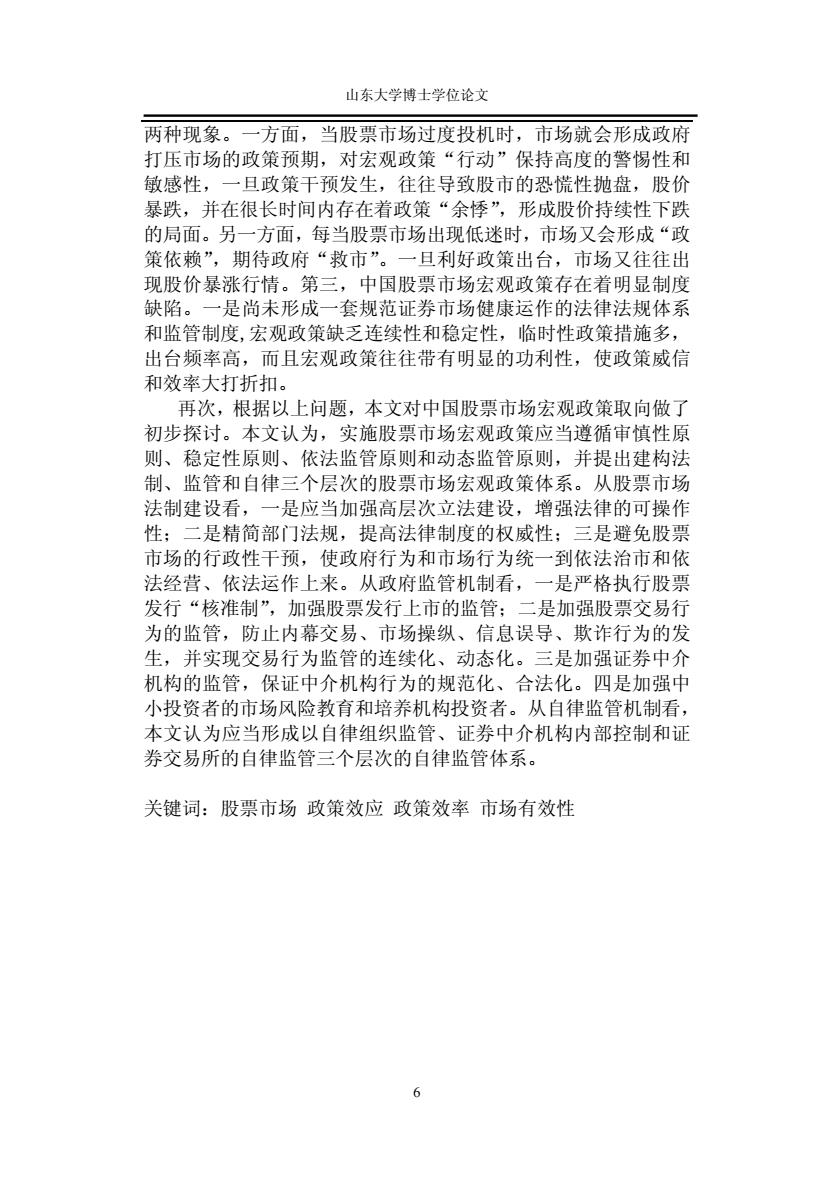
山东大学博士学位论文 两种现象。一方面,当股票市场过度投机时,市场就会形成政府 打压市场的政策预期,对宏观政策“行动”保持高度的警惕性和 敏感性,一旦政策干预发生,往往导致股市的恐慌性抛盘,股价 暴跌,并在很长时间内存在着政策“余悸”,形成股价持续性下跌 的局面。另一方面,每当股票市场出现低迷时,市场又会形成“政 策依赖”,期待政府“救市”。一旦利好政策出台,市场又往往出 现股价暴涨行情。第三,中国股票市场宏观政策存在着明显制度 缺陷。一是尚未形成一套规范证券市场健康运作的法律法规体系 和监管制度,宏观政策缺乏连续性和稳定性,临时性政策措施多, 出台频率高,而且宏观政策往往带有明显的功利性,使政策威信 和效率大打折扣。 再次,根据以上问题,本文对中国股票市场宏观政策取向做了 初步探讨。本文认为,实施股票市场宏观政策应当遵循审慎性原 则、稳定性原则、依法监管原则和动态监管原则,并提出建构法 制、监管和自律三个层次的股票市场宏观政策体系。从股票市场 法制建设看,一是应当加强高层次立法建设,增强法律的可操作 性;二是精简部门法规,提高法律制度的权威性;三是避免股票 市场的行政性干预,使政府行为和市场行为统一到依法治市和依 法经营、依法运作上来。从政府监管机制看,一是严格执行股票 发行“核准制”,加强股票发行上市的监管:二是加强股票交易行 为的监管,防止内幕交易、市场操纵、信息误导、欺诈行为的发 生,并实现交易行为监管的连续化、动态化。三是加强证券中介 机构的监管,保证中介机构行为的规范化、合法化。四是加强中 小投资者的市场风险教育和培养机构投资者。从自律监管机制看, 本文认为应当形成以自律组织监管、证券中介机构内部控制和证 券交易所的自律监管三个层次的自律监管体系。 关键词:股票市场政策效应政策效率市场有效性 6
山东大学博士学位论文 6 两种现象。一方面,当股票市场过度投机时,市场就会形成政府 打压市场的政策预期,对宏观政策“行动”保持高度的警惕性和 敏感性,一旦政策干预发生,往往导致股市的恐慌性抛盘,股价 暴跌,并在很长时间内存在着政策“余悸”,形成股价持续性下跌 的局面。另一方面,每当股票市场出现低迷时,市场又会形成“政 策依赖”,期待政府“救市”。一旦利好政策出台,市场又往往出 现股价暴涨行情。第三,中国股票市场宏观政策存在着明显制度 缺陷。一是尚未形成一套规范证券市场健康运作的法律法规体系 和监管制度,宏观政策缺乏连续性和稳定性,临时性政策措施多, 出台频率高,而且宏观政策往往带有明显的功利性,使政策威信 和效率大打折扣。 再次,根据以上问题,本文对中国股票市场宏观政策取向做了 初步探讨。本文认为,实施股票市场宏观政策应当遵循审慎性原 则、稳定性原则、依法监管原则和动态监管原则,并提出建构法 制、监管和自律三个层次的股票市场宏观政策体系。从股票市场 法制建设看,一是应当加强高层次立法建设,增强法律的可操作 性;二是精简部门法规,提高法律制度的权威性;三是避免股票 市场的行政性干预,使政府行为和市场行为统一到依法治市和依 法经营、依法运作上来。从政府监管机制看,一是严格执行股票 发行“核准制”,加强股票发行上市的监管;二是加强股票交易行 为的监管,防止内幕交易、市场操纵、信息误导、欺诈行为的发 生,并实现交易行为监管的连续化、动态化。三是加强证券中介 机构的监管,保证中介机构行为的规范化、合法化。四是加强中 小投资者的市场风险教育和培养机构投资者。从自律监管机制看, 本文认为应当形成以自律组织监管、证券中介机构内部控制和证 券交易所的自律监管三个层次的自律监管体系。 关键词:股票市场 政策效应 政策效率 市场有效性
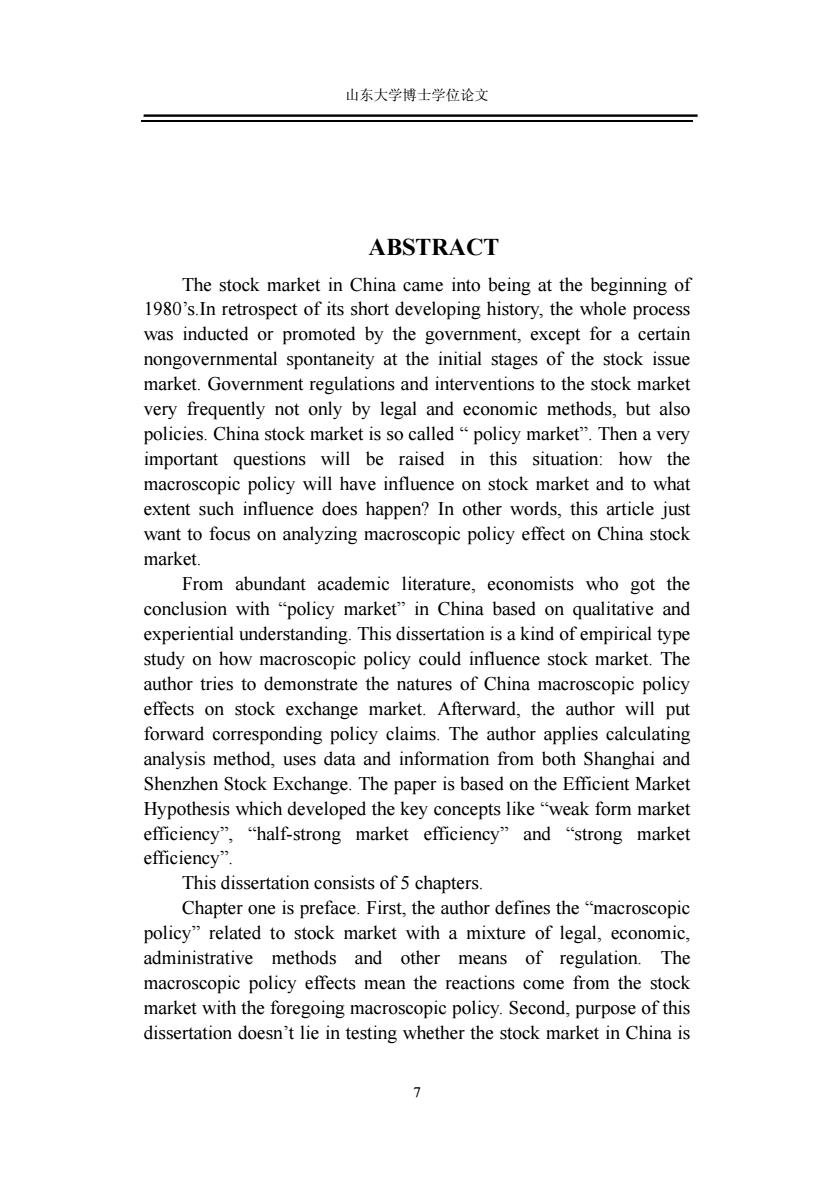
山东大学博士学位论文 ABSTRACT The stock market in China came into being at the beginning of 1980's.In retrospect of its short developing history,the whole process was inducted or promoted by the government,except for a certain nongovernmental spontaneity at the initial stages of the stock issue market.Government regulations and interventions to the stock market very frequently not only by legal and economic methods,but also policies.China stock market is so called"policy market".Then a very important questions will be raised in this situation:how the macroscopic policy will have influence on stock market and to what extent such influence does happen?In other words,this article just want to focus on analyzing macroscopic policy effect on China stock market. From abundant academic literature,economists who got the conclusion with "policy market"in China based on qualitative and experiential understanding.This dissertation is a kind of empirical type study on how macroscopic policy could influence stock market.The author tries to demonstrate the natures of China macroscopic policy effects on stock exchange market.Afterward,the author will put forward corresponding policy claims.The author applies calculating analysis method,uses data and information from both Shanghai and Shenzhen Stock Exchange.The paper is based on the Efficient Market Hypothesis which developed the key concepts like"weak form market efficiency”',half-strong market efficiency”and“strong market efficiency”. This dissertation consists of 5 chapters. Chapter one is preface.First,the author defines the"macroscopic policy"related to stock market with a mixture of legal,economic, administrative methods and other means of regulation.The macroscopic policy effects mean the reactions come from the stock market with the foregoing macroscopic policy.Second,purpose of this dissertation doesn't lie in testing whether the stock market in China is
山东大学博士学位论文 7 ABSTRACT The stock market in China came into being at the beginning of 1980’s.In retrospect of its short developing history, the whole process was inducted or promoted by the government, except for a certain nongovernmental spontaneity at the initial stages of the stock issue market. Government regulations and interventions to the stock market very frequently not only by legal and economic methods, but also policies. China stock market is so called “ policy market”. Then a very important questions will be raised in this situation: how the macroscopic policy will have influence on stock market and to what extent such influence does happen? In other words, this article just want to focus on analyzing macroscopic policy effect on China stock market. From abundant academic literature, economists who got the conclusion with “policy market” in China based on qualitative and experiential understanding. This dissertation is a kind of empirical type study on how macroscopic policy could influence stock market. The author tries to demonstrate the natures of China macroscopic policy effects on stock exchange market. Afterward, the author will put forward corresponding policy claims. The author applies calculating analysis method, uses data and information from both Shanghai and Shenzhen Stock Exchange. The paper is based on the Efficient Market Hypothesis which developed the key concepts like “weak form market efficiency”, “half-strong market efficiency” and “strong market efficiency”. This dissertation consists of 5 chapters. Chapter one is preface. First, the author defines the “macroscopic policy” related to stock market with a mixture of legal, economic, administrative methods and other means of regulation. The macroscopic policy effects mean the reactions come from the stock market with the foregoing macroscopic policy. Second, purpose of this dissertation doesn’t lie in testing whether the stock market in China is

山东大学博士学位论文 "policy market",but examining the characteristics of functional mechanism of stock market exerted by macroscopic policy,making basic evaluation of macroscopic policy posted on stock market,and putting forward policy suggestion regarding to how macroscopic policy should be carried out in stock market.Third,this dissertation points out the difference between“policy effect”and“policy efficiency”.Policy effect”ling in stock market doesn't mean“policy efficiency".Only when stock market reacts to policy information promptly,exactly,and fully can it be considered as"efficiency". Chapter two is a research statement about the Efficient Market Hypothesis.First,it gives the introduction of the fundamental theory frame,then it makes a detailed statement about three efficient markets on the basis of research literatures both in China and abroad.The foreign literatures demonstrate that this theory has been proved correct in most cases by statistic tests though the Effective Market Hypothesis is challenged by practice,From the point of views of Chinese economists,most of research conclusion indicates that the stock market of China didn't reach the"weak form efficiency"before 1992. but the stock market basically reached or almost reached to the "weak form efficiency"after 1993.If one considers whether it has reached "half-strong efficiency",there are large divergence ideas among academic circle. Chapter three elaborates the statistic test about the nature of the"weak form market efficiency"in China stock market.It takes the samples of daily stock price index from Shanghai Stock Exchange and Shenzhen Stock Exchange with the period of the very beginning of the stock market formation in Shanghai and Shenzhen (1991-2001).The number of observations is 2700 or so.All of the samples is divided into three phases.The first phase is from the initial transaction day to May 19th,1992,the second phase is from May 20th,1992 to December 15th,1996 and the third one is from December 16th,1996 to December 31st,2001.Three test methods:DF test,white noise test and runs test are applied to the statistic test on the "weak form efficiency"of China market respectively.The results of the tests demonstrate that the first phase not passed the three tests whether in Shanghai or Shenzhen.So we can conclude that the stock market in the first phase didn't reach the "weak form efficiency".But the second phase passed the three
山东大学博士学位论文 8 “policy market”, but examining the characteristics of functional mechanism of stock market exerted by macroscopic policy, making basic evaluation of macroscopic policy posted on stock market, and putting forward policy suggestion regarding to how macroscopic policy should be carried out in stock market. Third, this dissertation points out the difference between “policy effect” and “policy efficiency”. “Policy effect ” ling in stock market doesn’t mean “policy efficiency”. Only when stock market reacts to policy information promptly, exactly, and fully can it be considered as “efficiency”. Chapter two is a research statement about the Efficient Market Hypothesis. First, it gives the introduction of the fundamental theory frame, then it makes a detailed statement about three efficient markets on the basis of research literatures both in China and abroad. The foreign literatures demonstrate that this theory has been proved correct in most cases by statistic tests though the Effective Market Hypothesis is challenged by practice, From the point of views of Chinese economists, most of research conclusion indicates that the stock market of China didn’t reach the “ weak form efficiency” before 1992, but the stock market basically reached or almost reached to the “weak form efficiency” after 1993. If one considers whether it has reached “half-strong efficiency”,there are large divergence ideas among academic circle. Chapter three elaborates the statistic test about the nature of the“weak form market efficiency” in China stock market. It takes the samples of daily stock price index from Shanghai Stock Exchange and Shenzhen Stock Exchange with the period of the very beginning of the stock market formation in Shanghai and Shenzhen (1991 –2001). The number of observations is 2700 or so. All of the samples is divided into three phases. The first phase is from the initial transaction day to May 19th, 1992, the second phase is from May 20th, 1992 to December 15th, 1996 and the third one is from December 16th , 1996 to December 31st, 2001. Three test methods: DF test, white noise test and runs test are applied to the statistic test on the “weak form efficiency” of China market respectively. The results of the tests demonstrate that the first phase not passed the three tests whether in Shanghai or Shenzhen. So we can conclude that the stock market in the first phase didn’t reach the “weak form efficiency”. But the second phase passed the three
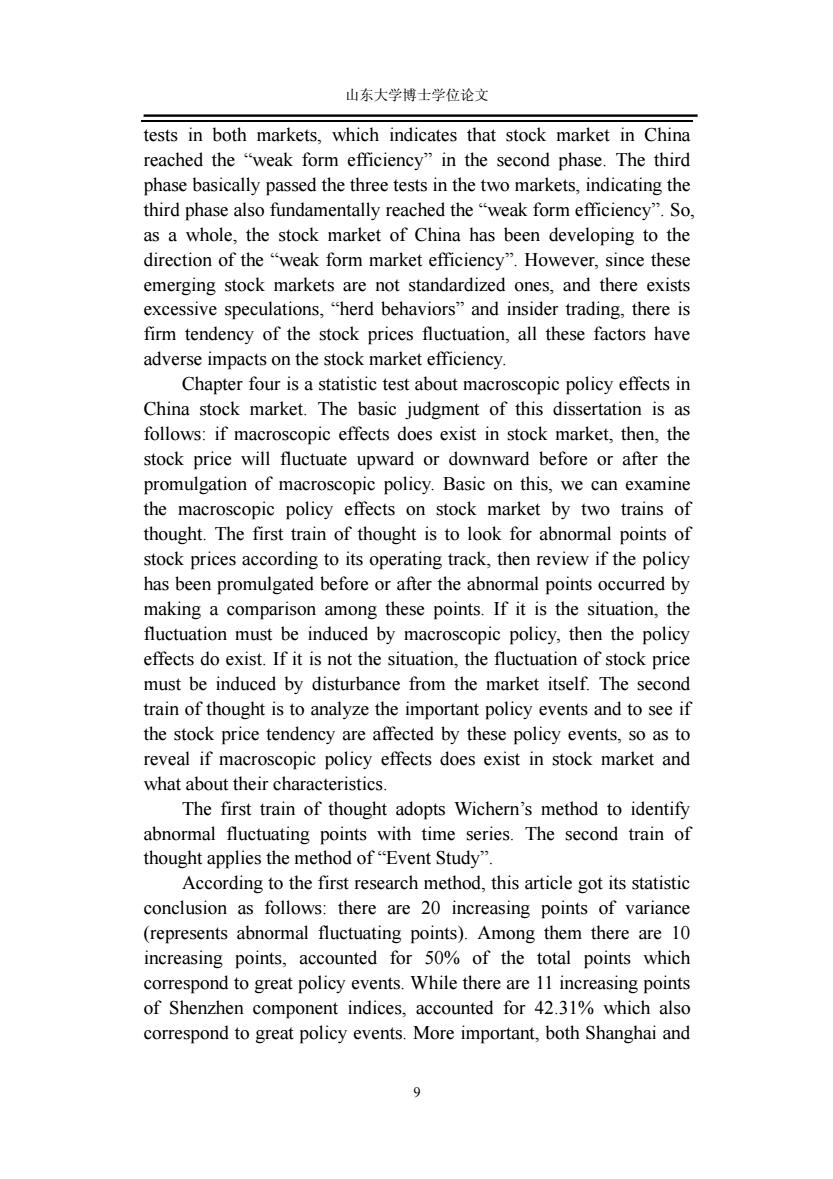
山东大学博士学位论文 tests in both markets,which indicates that stock market in China reached the "weak form efficiency"in the second phase.The third phase basically passed the three tests in the two markets,indicating the third phase also fundamentally reached the "weak form efficiency".So. as a whole,the stock market of China has been developing to the direction of the "weak form market efficiency".However,since these emerging stock markets are not standardized ones,and there exists excessive speculations,"herd behaviors"and insider trading,there is firm tendency of the stock prices fluctuation,all these factors have adverse impacts on the stock market efficiency. Chapter four is a statistic test about macroscopic policy effects in China stock market.The basic judgment of this dissertation is as follows:if macroscopic effects does exist in stock market,then,the stock price will fluctuate upward or downward before or after the promulgation of macroscopic policy.Basic on this,we can examine the macroscopic policy effects on stock market by two trains of thought.The first train of thought is to look for abnormal points of stock prices according to its operating track,then review if the policy has been promulgated before or after the abnormal points occurred by making a comparison among these points.If it is the situation,the fluctuation must be induced by macroscopic policy,then the policy effects do exist.If it is not the situation,the fluctuation of stock price must be induced by disturbance from the market itself.The second train of thought is to analyze the important policy events and to see if the stock price tendency are affected by these policy events,so as to reveal if macroscopic policy effects does exist in stock market and what about their characteristics. The first train of thought adopts Wichern's method to identify abnormal fluctuating points with time series.The second train of thought applies the method of"Event Study". According to the first research method,this article got its statistic conclusion as follows:there are 20 increasing points of variance (represents abnormal fluctuating points).Among them there are 10 increasing points,accounted for 50%of the total points which correspond to great policy events.While there are 11 increasing points of Shenzhen component indices,accounted for 42.31%which also correspond to great policy events.More important,both Shanghai and
山东大学博士学位论文 9 tests in both markets, which indicates that stock market in China reached the “weak form efficiency” in the second phase. The third phase basically passed the three tests in the two markets, indicating the third phase also fundamentally reached the “weak form efficiency”. So, as a whole, the stock market of China has been developing to the direction of the “weak form market efficiency”. However, since these emerging stock markets are not standardized ones, and there exists excessive speculations, “herd behaviors” and insider trading, there is firm tendency of the stock prices fluctuation, all these factors have adverse impacts on the stock market efficiency. Chapter four is a statistic test about macroscopic policy effects in China stock market. The basic judgment of this dissertation is as follows: if macroscopic effects does exist in stock market, then, the stock price will fluctuate upward or downward before or after the promulgation of macroscopic policy. Basic on this, we can examine the macroscopic policy effects on stock market by two trains of thought. The first train of thought is to look for abnormal points of stock prices according to its operating track, then review if the policy has been promulgated before or after the abnormal points occurred by making a comparison among these points. If it is the situation, the fluctuation must be induced by macroscopic policy, then the policy effects do exist. If it is not the situation, the fluctuation of stock price must be induced by disturbance from the market itself. The second train of thought is to analyze the important policy events and to see if the stock price tendency are affected by these policy events, so as to reveal if macroscopic policy effects does exist in stock market and what about their characteristics. The first train of thought adopts Wichern’s method to identify abnormal fluctuating points with time series. The second train of thought applies the method of “Event Study”. According to the first research method, this article got its statistic conclusion as follows: there are 20 increasing points of variance (represents abnormal fluctuating points). Among them there are 10 increasing points, accounted for 50% of the total points which correspond to great policy events. While there are 11 increasing points of Shenzhen component indices, accounted for 42.31% which also correspond to great policy events. More important, both Shanghai and

山东大学博士学位论文 Shenzhen have high abnormal fluctuations of variance which were induced by policy factors.This indicates that so the promulgation of policy not only induces the fluctuation of stock price,but also brings market attack.So the macroscopic policy constitutes a very important factor in causing the stock price fluctuation,even controls the stock price direction to a large extent.From this point,the judgment about China stock market is a "policy market"to some extent gets statistic verification. According to the second method,the statistical conclusion is: First,no matter it is good news or bad one,the stock markets have already had the expectation for policy effects before the policy comes out.It indicates that there are some well-informed people within the markets who could obtain the policy news in advance and take actions. Second,as far as Shanghai stock market is concerned,when the good news is coming on,accumulated average abnormal return increases sharply and then shows a tendency of constantly slow upgrading; When bad news is coming on,accumulated average abnormal return decreases greatly,and then shows a tendency of large scope decreasing. Both of these two phenomena make it clear that the market have a "deferral effect"to the macro policy,especially to the bad news Consequently,there exists "underreaction"in market to the political information.Third,if we check the Shenzhen Stock Exchange,when good news comes on,accumulated average abnormal return increases sharply and then shows a tendency of small scope of decreasing.This indicates that Shenzhen differs from Shanghai stock market with the existence of "overreaction".When bad news comes on,the result is similar to Shanghai stock market,that is an accumulated average abnormal return decreases greatly,and then shows a tendency of large scope of decreasing.This indicates that the market have an obvious deferral effect to the macro policy,especially to the bad news.Fourth, from what have been discussed above,the stock markets in China are sensitive to the macro policy.The carrying out of macro policy will cause sharp fluctuation in stock market.The conclusion that stock market has a strong policy effect is consistent with the conclusion drawn from the first method.But,with the existence of "underreaction"and "overreaction",the stock market didn't reach half-strong efficency"from reaction efficiency of stock markets to the 0
山东大学博士学位论文 10 Shenzhen have high abnormal fluctuations of variance which were induced by policy factors. This indicates that so the promulgation of policy not only induces the fluctuation of stock price, but also brings market attack. So the macroscopic policy constitutes a very important factor in causing the stock price fluctuation, even controls the stock price direction to a large extent. From this point, the judgment about China stock market is a “policy market” to some extent gets statistic verification. According to the second method, the statistical conclusion is: First, no matter it is good news or bad one, the stock markets have already had the expectation for policy effects before the policy comes out. It indicates that there are some well-informed people within the markets who could obtain the policy news in advance and take actions. Second, as far as Shanghai stock market is concerned, when the good news is coming on, accumulated average abnormal return increases sharply and then shows a tendency of constantly slow upgrading; When bad news is coming on, accumulated average abnormal return decreases greatly, and then shows a tendency of large scope decreasing. Both of these two phenomena make it clear that the market have a “deferral effect” to the macro policy, especially to the bad news. Consequently , there exists “underreaction” in market to the political information. Third, if we check the Shenzhen Stock Exchange, when good news comes on, accumulated average abnormal return increases sharply and then shows a tendency of small scope of decreasing. This indicates that Shenzhen differs from Shanghai stock market with the existence of “overreaction”. When bad news comes on, the result is similar to Shanghai stock market, that is an accumulated average abnormal return decreases greatly, and then shows a tendency of large scope of decreasing. This indicates that the market have an obvious deferral effect to the macro policy, especially to the bad news. Fourth, from what have been discussed above, the stock markets in China are sensitive to the macro policy. The carrying out of macro policy will cause sharp fluctuation in stock market. The conclusion that stock market has a strong policy effect is consistent with the conclusion drawn from the first method. But, with the existence of “underreaction” and “overreaction”, the stock market didn’t reach “half-strong efficency” from reaction efficiency of stock markets to the